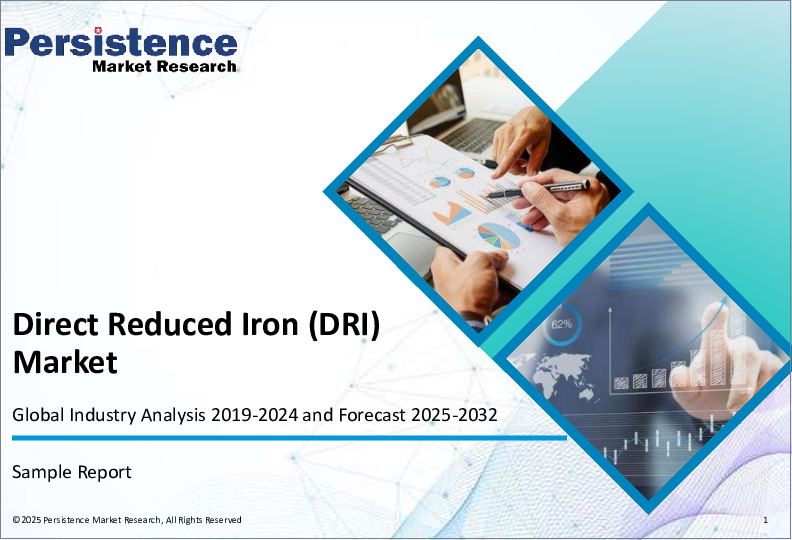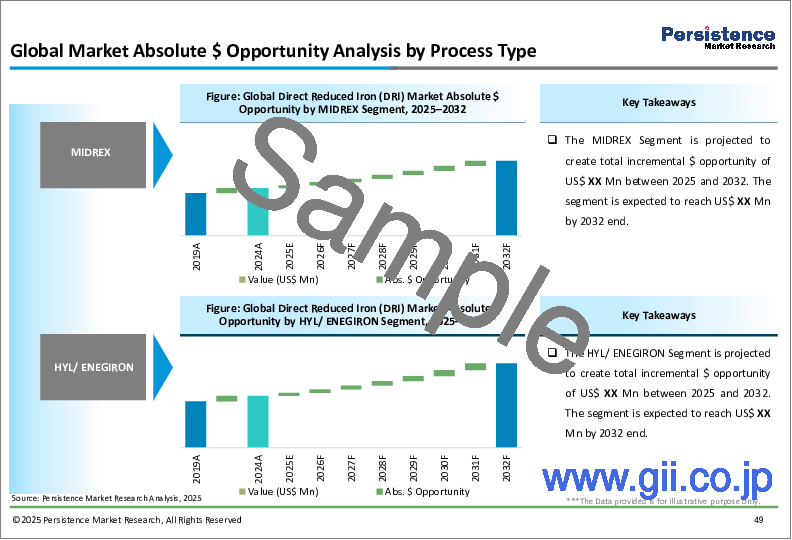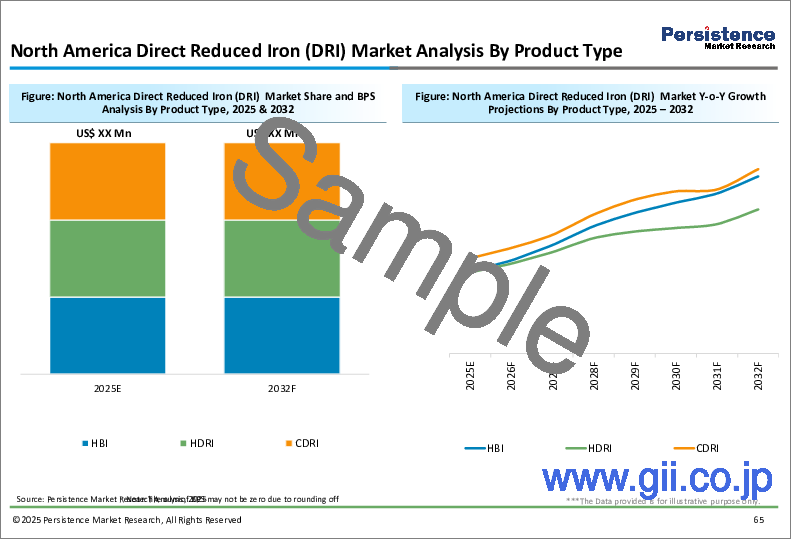|
|
市場調査レポート
商品コード
1773771
直接還元鉄(DRI)市場:世界の産業分析、市場規模・シェア・成長・動向、将来予測 (2025~2032年)Direct Reduced Iron (DRI) Market: Global Industry Analysis, Size, Share, Growth, Trends, and Forecast, 2025 - 2032 |
||||||
カスタマイズ可能
|
|||||||
| 直接還元鉄(DRI)市場:世界の産業分析、市場規模・シェア・成長・動向、将来予測 (2025~2032年) |
|
出版日: 2025年07月14日
発行: Persistence Market Research
ページ情報: 英文 191 Pages
納期: 2~5営業日
|
全表示
- 概要
- 目次
Persistence Market Research社はこのほど、世界の直接還元鉄(DRI)市場に関する包括的な分析を発表しました。当レポートでは、市場促進要因・動向・機会・課題などの重要な市場力学を徹底的に評価し、市場構造に関する詳細な洞察を提供しています。当レポートは、世界の直接還元鉄(DRI)市場の予測成長軌道 (2025~2032年) を概説する独占的データと統計を掲載しています。
主要な洞察
- 直接還元鉄(DRI)の市場規模 (2025年):437億米ドル
- 市場規模の予測 (金額ベース、2032年):706億米ドル
- 世界市場の成長率 (CAGR、2025~2032年):7.1%
直接還元鉄(DRI)市場 - 分析範囲
直接還元鉄(DRI)はスポンジ鉄としても知られ、鉄鉱石を溶融することなく、還元ガスや石炭を使って固体状態で直接還元して製造されます。DRIは、製鉄における電気炉(EAF)や誘導炉の高品質な原料として機能し、スクラップと比較して一貫した化学組成、低不純物、環境上の利点を提供します。世界のDRI市場は、スクラップ価格が変動し、環境規制が強化される中、金属スクラップの代替品を求める鉄鋼メーカーに対応しています。市場成長の原動力は、建設、自動車、インフラ、再生可能エネルギーの各分野における鉄鋼需要の増加と、鉄鋼業界における脱炭素化への関心の高まりです。
市場成長の促進要因:
世界の直接還元鉄市場は、DRIのような高品質の鉄インプットに大きく依存する電気炉(EAF)技術の採用拡大など、いくつかの重要な要因によって推進されています。都市化、工業化、インフラ投資を原動力とする世界の鉄鋼生産の増加は、安定した低残渣原料としてのDRI需要を促進しています。環境規制や持続可能性の目標は、鉄鋼メーカーに二酸化炭素排出量の削減を促しており、DRIは従来の高炉操業に比べて二酸化炭素排出量が少ないため、好ましい原料として位置づけられています。さらに、スクラップ市場の変動と供給制約の増大がDRIの採用をさらに後押しし、鉄鋼メーカーの安定操業を保証しています。
市場の抑制要因:
有望な成長見通しにもかかわらず、直接還元鉄市場は、DRI生産設備に関連する高い設備投資と操業コストに関する課題に直面しています。ガスベースのDRIプロセスでは天然ガスに依存するため、特に手ごろな天然ガスインフラがない地域では、メーカーは価格変動と供給リスクにさらされます。さらに、DRIプラントの操業は技術的に複雑であり、高純度の鉄鉱石が必要なため、特定の新興国市場ではDRI生産へのアクセスが制限されます。石炭ベースのDRIプロセスから排出されるCO2をめぐる環境問題への懸念も、規制上・社会上の課題となっています。こうした技術的、経済的、環境的ハードルに対処することが、市場の持続的拡大には不可欠です。
市場機会:
直接還元鉄市場は、鉄鋼業界におけるグリーンな鉄鋼生産の世界の推進と脱炭素化イニシアチブを原動力とする大きな成長機会を示しています。水素をベースとするDRI技術の革新は、従来の天然ガスをベースとするプロセスと比較して炭素排出量を大幅に削減する道筋を提供し、ゲームチェンジャーとして浮上しています。再生可能エネルギーと水素インフラへの投資拡大により、持続可能なDRI生産に有利な条件が整いつつあります。さらに、モジュール式の小規模DRIプラントの開発は、鉄鋼市場が小さい地域や、スクラップの利用可能性が限られている地域に新たな展望を提供します。このような変革の機会を活用し、進化する鉄鋼情勢において市場の主導権を確保するためには、戦略的協力、技術的進歩、政策支援が不可欠です。
当レポートで回答する主な質問
- 世界の直接還元鉄市場の成長を促進する主な要因は何か?
- さまざまな製鋼プロセスでDRIの採用を促進している生産技術や用途は何か?
- 技術進歩は直接還元鉄市場の競合情勢をどのように変えているのか?
- 直接還元鉄市場に貢献している主要企業はどれか、また市場の関連性を維持するためにどのような戦略を採用しているか?
- 世界の直接還元鉄市場の新たな動向と将来性は?
目次
第1章 エグゼクティブサマリー
第2章 市場概要
- 市場の範囲と定義
- 市場力学
- 促進要因
- 抑制要因
- 機会
- 課題
- 主な動向
- 製品ライフサイクル分析
- 直接還元鉄(DRI)市場:バリューチェーン
- 原材料サプライヤー一覧
- メーカー一覧
- 販売代理店一覧
- 収益性分析
- 予測要因:関連性と影響
- COVID-19の影響評価
- PESTLE分析
- ポーターのファイブフォース分析
- 地政学的緊張:市場への影響
- 規制とプロセスタイプの情勢
第3章 マクロ経済要因
- 世界のセクター別展望
- 世界のGDP成長見通し
- 世界の親市場の概要
第4章 価格動向分析(2019~2032年)
- 主なハイライト
- 製品価格に影響を与える主な要因
- 製品種類別/構成別/プロセスの種類別の価格
- 地域別の価格と製品嗜好
第5章 世界の直接還元鉄(DRI)市場の展望:過去 (2019~2024年) と予測 (2025~2032年)
- 主なハイライト
- 市場規模と前年比成長率 (金額ベース)
- 絶対的収益機会
- 市場規模の分析と予測 (金額ベース)
- 過去の市場規模の分析 (2019~2024年)
- 現在の市場規模の予測 (2025~2032年)
- 世界の直接還元鉄(DRI)市場の展望:製品種類別
- イントロダクション/主な分析結果
- 過去の市場規模の分析:製品種類別 (金額・数量ベース、2019~2024年)
- 現在の市場規模の予測:製品種類別 (金額・数量ベース、2025~2032年)
- HBI
- HDRI
- CDRI
- 市場魅力分析:製品種類別
- 世界の直接還元鉄(DRI)市場の展望:プロセスの種類別
- イントロダクション/主な分析結果
- 過去の市場規模の分析:プロセスの種類別 (金額・数量ベース、2019~2024年)
- 現在の市場規模の予測:プロセスの種類別 (金額・数量ベース、2025~2032年)
- ミドレックス
- HYL/エネギロン
- ペレッド
- ロータリーキルン
- 市場魅力分析:プロセスの種類別
第6章 世界の直接還元鉄(DRI)市場の展望:地域別
- 主なハイライト
- 過去の市場規模の分析:地域別 (金額・数量ベース、2019~2024年)
- 現在の市場規模の予測:地域別 (金額・数量ベース、2025~2032年)
- 北米
- 欧州
- 東アジア
- 南アジアとオセアニア
- ラテンアメリカ
- 中東・アフリカ
- 市場魅力分析:地域別
第7章 北米の直接還元鉄(DRI)市場の展望:過去(2019~2024年)および予測(2025~2032年)
第8章 欧州の直接還元鉄(DRI)市場の展望:過去(2019~2024年)および予測(2025~2032年)
第9章 東アジアの直接還元鉄(DRI)市場の展望:過去(2019~2024年)および予測(2025~2032年)
第10章 南アジア・オセアニアの直接還元鉄(DRI)市場の展望:過去(2019~2024年)および予測(2025~2032年)
第11章 ラテンアメリカの直接還元鉄(DRI)市場の展望:過去(2019~2024年)および予測(2025~2032年)
第12章 中東・アフリカの直接還元鉄(DRI)市場の展望:過去(2019~2024年)および予測(2025~2032年)
第13章 競合情勢
- 市場シェア分析 (2025年)
- 市場構造
- 競合強度マップ:市場別
- 競合ダッシュボード
- 企業プロファイル (詳細:概要、財務、戦略、最近の動向)
- Indorama Ventures Public Company Limited
- Phoenix Technologies International, LLC
- Biffa
- Alpek
- Plastipak Packaging
- Extrupet Group(Pty)Ltd
- Alpla
- JP Recycling Ltd
- Evergreen Plastics, Inc.
- PolyQuest
- Iterum(PET Baltija)
- Ganesha Ecosphere Ltd.
注:企業リストは網羅的なものではなく、分析の過程でさらに追加される可能性があります。
第14章 付録
- 分析手法
- 分析の前提
- 頭字語と略語
Persistence Market Research has recently released a comprehensive report on the worldwide market for Direct Reduced Iron (DRI). The report offers a thorough assessment of crucial market dynamics, including drivers, trends, opportunities, and challenges, providing detailed insights into the market structure. This research publication presents exclusive data and statistics outlining the anticipated growth trajectory of the global Direct Reduced Iron market from 2025 to 2032.
Key Insights:
- Direct Reduced Iron Market Size (2025E): USD 43.7 Billion
- Projected Market Value (2032F): USD 70.6 Billion
- Global Market Growth Rate (CAGR 2025 to 2032): 7.1%
Direct Reduced Iron Market - Report Scope:
Direct Reduced Iron (DRI), also known as sponge iron, is produced by reducing iron ore directly in its solid state using reducing gases or coal, without melting the iron. DRI serves as a high-quality feedstock for electric arc furnaces (EAF) and induction furnaces in steelmaking, providing consistent chemical composition, lower impurities, and environmental benefits compared to scrap. The global DRI market caters to steel manufacturers seeking alternatives to scrap metal amid fluctuating scrap prices and tightening environmental regulations. Market growth is driven by increasing demand for steel across construction, automotive, infrastructure, and renewable energy sectors, alongside rising emphasis on decarbonization in the steel industry.
Market Growth Drivers:
The global Direct Reduced Iron market is propelled by several key factors, including the growing adoption of electric arc furnace (EAF) technology, which relies heavily on high-quality iron inputs such as DRI. Rising global steel production, driven by urbanization, industrialization, and infrastructure investments, fuels demand for DRI as a consistent and low-residual feedstock. Environmental regulations and sustainability goals are encouraging steelmakers to reduce carbon emissions, positioning DRI as a preferred raw material due to its lower CO2 footprint compared to traditional blast furnace operations. Additionally, increasing volatility and supply constraints in scrap markets further boost DRI adoption, ensuring stable operations for steel producers.
Market Restraints:
Despite promising growth prospects, the Direct Reduced Iron market faces challenges related to high capital investment and operational costs associated with DRI production facilities. The dependence on natural gas for gas-based DRI processes exposes manufacturers to price volatility and supply risks, particularly in regions lacking affordable natural gas infrastructure. Furthermore, technological complexities in DRI plant operations and the need for high-purity iron ore limits the accessibility of DRI production in certain developing markets. Environmental concerns around CO2 emissions from coal-based DRI processes also pose regulatory and social challenges. Addressing these technical, economic, and environmental hurdles is crucial for sustained market expansion.
Market Opportunities:
The Direct Reduced Iron market presents significant growth opportunities driven by the global push for green steel production and decarbonization initiatives in the steel industry. Innovations in hydrogen-based DRI technology are emerging as a game-changer, offering a pathway to significantly lower carbon emissions compared to conventional natural gas-based processes. Expanding investments in renewable energy and hydrogen infrastructure create favorable conditions for sustainable DRI production. Moreover, the development of modular, smaller-scale DRI plants offers new prospects for regions with smaller steel markets or limited scrap availability. Strategic collaborations, technological advancements, and policy support will be essential to capitalize on these transformative opportunities and secure market leadership in the evolving steel landscape.
Key Questions Answered in the Report:
- What are the primary factors driving the growth of the Direct Reduced Iron market globally?
- Which production technologies and applications are driving DRI adoption across different steelmaking processes?
- How are technological advancements reshaping the competitive landscape of the Direct Reduced Iron market?
- Who are the key players contributing to the Direct Reduced Iron market, and what strategies are they employing to maintain market relevance?
- What are the emerging trends and future prospects in the global Direct Reduced Iron market?
Competitive Intelligence and Business Strategy:
These companies invest in R&D to develop advanced DRI technologies, including hydrogen-based reduction processes, flexible plant designs, and integrated digital solutions for plant operations. Collaborations with steel producers, technology licensors, and governments facilitate market adoption and promote sustainable production practices. Moreover, emphasis on cost efficiency, environmental compliance, and global project execution capabilities enables key players to strengthen their market position and support the steel industry's transition toward greener production.
Key Companies Profiled:
- Qatar Steel
- Kobe Steel Ltd
- ArcelorMittal
- NUCOR
- Midrex Technologies Inc.
- Khouzestan Steel Company
- Welspun Group
- Jindal Shadeed Iron & Steel LLC
- AM/NS India
- Tosyali Algeria A.S.
Direct Reduced Iron Market Research Segmentation:
The Direct Reduced Iron market encompasses a diverse range of production methods, applications, and end-user segments, addressing varied needs across global steel manufacturing.
By Product Type:
- HBI
- HDRI
- CDRI
By Process Type:
- MIDREX
- HYL/ ENEGIRON
- PERED
- Rotary Kiln
By Region:
- North America
- Europe
- East Asia
- South Asia & Pacific
- Latin America
- Middle East and Africa
Table of Contents
1. Executive Summary
- 1.1. Global Direct Reduced Iron (DRI) Market Snapshot, 2025 and 2032
- 1.2. Market Opportunity Assessment, 2025-2032, US$ Mn
- 1.3. Key Market Trends
- 1.4. Future Market Projections
- 1.5. Premium Market Insights
- 1.6. Industry Developments and Key Market Events
- 1.7. PMR Analysis and Recommendations
2. Market Overview
- 2.1. Market Scope and Definition
- 2.2. Market Dynamics
- 2.2.1. Drivers
- 2.2.2. Restraints
- 2.2.3. Opportunity
- 2.2.4. Challenges
- 2.2.5. Key Trends
- 2.3. Product Lifecycle Analysis
- 2.4. Direct Reduced Iron (DRI) Market: Value Chain
- 2.4.1. List of Raw Material Suppliers
- 2.4.2. List of Manufacturers
- 2.4.3. List of Distributors
- 2.4.4. Profitability Analysis
- 2.5. Forecast Factors - Relevance and Impact
- 2.6. Covid-19 Impact Assessment
- 2.7. PESTLE Analysis
- 2.8. Porter Five Force's Analysis
- 2.9. Geopolitical Tensions: Market Impact
- 2.10. Regulatory and Process Type Landscape
3. Macro-Economic Factors
- 3.1. Global Sectorial Outlook
- 3.2. Global GDP Growth Outlook
- 3.3. Global Parent Market Overview
4. Price Trend Analysis, 2019-2032
- 4.1. Key Highlights
- 4.2. Key Factors Impacting Product Prices
- 4.3. Prices By Product Type/Composition/Process Type
- 4.4. Regional Prices and Product Preferences
5. Global Direct Reduced Iron (DRI) Market Outlook: Historical (2019-2024) and Forecast (2025-2032)
- 5.1. Key Highlights
- 5.1.1. Market Size and Y-o-Y Growth
- 5.1.2. Absolute $ Opportunity
- 5.2. Market Size (US$ Mn) Analysis and Forecast
- 5.2.1. Historical Market Size Analysis, 2019-2024
- 5.2.2. Current Market Size Forecast, 2025-2032
- 5.3. Global Direct Reduced Iron (DRI) Market Outlook: Product Type
- 5.3.1. Introduction / Key Findings
- 5.3.2. Historical Market Size (US$ Mn) and Volume (Tons) Analysis By Product Type, 2019-2024
- 5.3.3. Current Market Size (US$ Mn) and Volume (Tons) Forecast By Product Type, 2025-2032
- 5.3.3.1. HBI
- 5.3.3.2. HDRI
- 5.3.3.3. CDRI
- 5.4. Market Attractiveness Analysis: Product Type
- 5.5. Global Direct Reduced Iron (DRI) Market Outlook: Process Type
- 5.5.1. Introduction / Key Findings
- 5.5.2. Historical Market Size (US$ Mn) and Volume (Tons) Analysis By Process Type, 2019-2024
- 5.5.3. Current Market Size (US$ Mn) and Volume (Tons) Forecast By Process Type, 2025-2032
- 5.5.3.1. MIDREX
- 5.5.3.2. HYL/ ENEGIRON
- 5.5.3.3. PERED
- 5.5.3.4. Rotary Kiln
- 5.6. Market Attractiveness Analysis: Process Type
6. Global Direct Reduced Iron (DRI) Market Outlook: Region
- 6.1. Key Highlights
- 6.2. Historical Market Size (US$ Mn) and Volume (Tons) Analysis By Region, 2019-2024
- 6.3. Current Market Size (US$ Mn) and Volume (Tons) Forecast By Region, 2025-2032
- 6.3.1. North America
- 6.3.2. Europe
- 6.3.3. East Asia
- 6.3.4. South Asia and Oceania
- 6.3.5. Latin America
- 6.3.6. Middle East & Africa
- 6.4. Market Attractiveness Analysis: Region
7. North America Direct Reduced Iron (DRI) Market Outlook: Historical (2019-2024) and Forecast (2025-2032)
- 7.1. Key Highlights
- 7.2. Pricing Analysis
- 7.3. Historical Market Size (US$ Mn) and Volume (Tons) Analysis By Market, 2019-2024
- 7.3.1. By Country
- 7.3.2. By Product Type
- 7.3.3. By Process Type
- 7.4. Current Market Size (US$ Mn) and Volume (Tons) Forecast By Country, 2025-2032
- 7.4.1. U.S.
- 7.4.2. Canada
- 7.5. Current Market Size (US$ Mn) and Volume (Tons) Forecast by Product Type, 2025-2032
- 7.5.1. HBI
- 7.5.2. HDRI
- 7.5.3. CDRI
- 7.6. Current Market Size (US$ Mn) and Volume ( Tons) Forecast By Process Type, 2025-2032
- 7.6.1. MIDREX
- 7.6.2. HYL/ ENEGIRON
- 7.6.3. PERED
- 7.6.4. Rotary Kiln
- 7.7. Market Attractiveness Analysis
8. Europe Direct Reduced Iron (DRI) Market Outlook: Historical (2019-2024) and Forecast (2025-2032)
- 8.1. Key Highlights
- 8.2. Pricing Analysis
- 8.3. Historical Market Size (US$ Mn) and Volume (Tons) Analysis By Market, 2019-2024
- 8.3.1. By Country
- 8.3.2. By Product Type
- 8.3.3. By Process Type
- 8.4. Current Market Size (US$ Mn) and Volume (Tons) Forecast By Country, 2025-2032
- 8.4.1. Germany
- 8.4.2. France
- 8.4.3. U.K.
- 8.4.4. Italy
- 8.4.5. Spain
- 8.4.6. Russia
- 8.4.7. Rest of Europe
- 8.5. Current Market Size (US$ Mn) and Volume (Tons) Forecast By Product Type, 2025-2032
- 8.5.1. HBI
- 8.5.2. HDRI
- 8.5.3. CDRI
- 8.6. Current Market Size (US$ Mn) and Volume ( Tons) Forecast By Process Type, 2025-2032
- 8.6.1. MIDREX
- 8.6.2. HYL/ ENEGIRON
- 8.6.3. PERED
- 8.6.4. Rotary Kiln
- 8.7. Market Attractiveness Analysis
9. East Asia Direct Reduced Iron (DRI) Market Outlook: Historical (2019-2024) and Forecast (2025-2032)
- 9.1. Key Highlights
- 9.2. Pricing Analysis
- 9.3. Historical Market Size (US$ Mn) and Volume (Tons) Analysis By Market, 2019-2024
- 9.3.1. By Country
- 9.3.2. By Product Type
- 9.3.3. By Process Type
- 9.4. Current Market Size (US$ Mn) and Volume ( Tons) Forecast By Country, 2025-2032
- 9.4.1. China
- 9.4.2. Japan
- 9.4.3. South Korea
- 9.5. Current Market Size (US$ Mn) and Volume (Tons) Forecast By Product Type, 2025-2032
- 9.5.1. HBI
- 9.5.2. HDRI
- 9.5.3. CDRI
- 9.6. Current Market Size (US$ Mn) and Volume ( Tons) Forecast By Process Type, 2025-2032
- 9.6.1. MIDREX
- 9.6.2. HYL/ ENEGIRON
- 9.6.3. PERED
- 9.6.4. Rotary Kiln
- 9.7. Market Attractiveness Analysis
10. South Asia & Oceania Direct Reduced Iron (DRI) Market Outlook: Historical (2019-2024) and Forecast (2025-2032)
- 10.1. Key Highlights
- 10.2. Pricing Analysis
- 10.3. Historical Market Size (US$ Mn) and Volume (Tons) Analysis By Market, 2019-2024
- 10.3.1. By Country
- 10.3.2. By Product Type
- 10.3.3. By Process Type
- 10.4. Current Market Size (US$ Mn) and Volume (Tons) Forecast By Country, 2025-2032
- 10.4.1. India
- 10.4.2. Southeast Asia
- 10.4.3. ANZ
- 10.4.4. Rest of South Asia & Oceania
- 10.5. Current Market Size (US$ Mn) and Volume (Tons) Forecast By Product Type, 2025-2032
- 10.5.1. HBI
- 10.5.2. HDRI
- 10.5.3. CDRI
- 10.6. Current Market Size (US$ Mn) and Volume ( Tons) Forecast By Process Type, 2025-2032
- 10.6.1. MIDREX
- 10.6.2. HYL/ ENEGIRON
- 10.6.3. PERED
- 10.6.4. Rotary Kiln
- 10.7. Market Attractiveness Analysis
11. Latin America Direct Reduced Iron (DRI) Market Outlook: Historical (2019-2024) and Forecast (2025-2032)
- 11.1. Key Highlights
- 11.2. Pricing Analysis
- 11.3. Historical Market Size (US$ Mn) and Volume (Tons) Analysis By Market, 2019-2024
- 11.3.1. By Country
- 11.3.2. By Product Type
- 11.3.3. By Process Type
- 11.4. Current Market Size (US$ Mn) and Volume (Tons) Forecast By Country, 2025-2032
- 11.4.1. Brazil
- 11.4.2. Mexico
- 11.4.3. Rest of Latin America
- 11.5. Current Market Size (US$ Mn) and Volume (Tons) Forecast By Product Type, 2025-2032
- 11.5.1. HBI
- 11.5.2. HDRI
- 11.5.3. CDRI
- 11.6. Current Market Size (US$ Mn) and Volume ( Tons) Forecast By Process Type, 2025-2032
- 11.6.1. MIDREX
- 11.6.2. HYL/ ENEGIRON
- 11.6.3. PERED
- 11.6.4. Rotary Kiln
- 11.7. Market Attractiveness Analysis
12. Middle East & Africa Direct Reduced Iron (DRI) Market Outlook: Historical (2019-2024) and Forecast (2025-2032)
- 12.1. Key Highlights
- 12.2. Pricing Analysis
- 12.3. Historical Market Size (US$ Mn) and Volume (Tons) Analysis By Market, 2019-2024
- 12.3.1. By Country
- 12.3.2. By Product Type
- 12.3.3. By Process Type
- 12.4. Current Market Size (US$ Mn) and Volume (Tons) Forecast By Country, 2025-2032
- 12.4.1. GCC
- 12.4.2. South Africa
- 12.4.3. Northern Africa
- 12.4.4. Rest of Middle East & Africa
- 12.5. Current Market Size (US$ Mn) and Volume (Tons) Forecast By Product Type, 2025-2032
- 12.5.1. HBI
- 12.5.2. HDRI
- 12.5.3. CDRI
- 12.6. Current Market Size (US$ Mn) and Volume ( Tons) Forecast By Process Type, 2025-2032
- 12.6.1. MIDREX
- 12.6.2. HYL/ ENEGIRON
- 12.6.3. PERED
- 12.6.4. Rotary Kiln
- 12.7. Market Attractiveness Analysis
13. Competition Landscape
- 13.1. Market Share Analysis, 2025
- 13.2. Market Structure
- 13.2.1. Competition Intensity Mapping By Market
- 13.2.2. Competition Dashboard
- 13.2.3. Apparent Production Capacity
- 13.3. Company Profiles (Details - Overview, Financials, Strategy, Recent Developments)
- 13.3.1. Indorama Ventures Public Company Limited
- 13.3.1.1. Overview
- 13.3.1.2. Segments and Products
- 13.3.1.3. Key Financials
- 13.3.1.4. Market Developments
- 13.3.1.5. Market Strategy
- 13.3.2. Phoenix Technologies International, LLC
- 13.3.3. Biffa
- 13.3.4. Alpek
- 13.3.5. Plastipak Packaging
- 13.3.6. Extrupet Group (Pty) Ltd
- 13.3.7. Alpla
- 13.3.8. JP Recycling Ltd
- 13.3.9. Evergreen Plastics, Inc.
- 13.3.10. PolyQuest
- 13.3.11. Iterum (PET Baltija)
- 13.3.12. Ganesha Ecosphere Ltd.
- 13.3.1. Indorama Ventures Public Company Limited
Note: List of companies is not exhaustive. It is subject to further augmentation during course of research
14. Appendix
- 14.1. Research Methodology
- 14.2. Research Assumptions
- 14.3. Acronyms and Abbreviations






